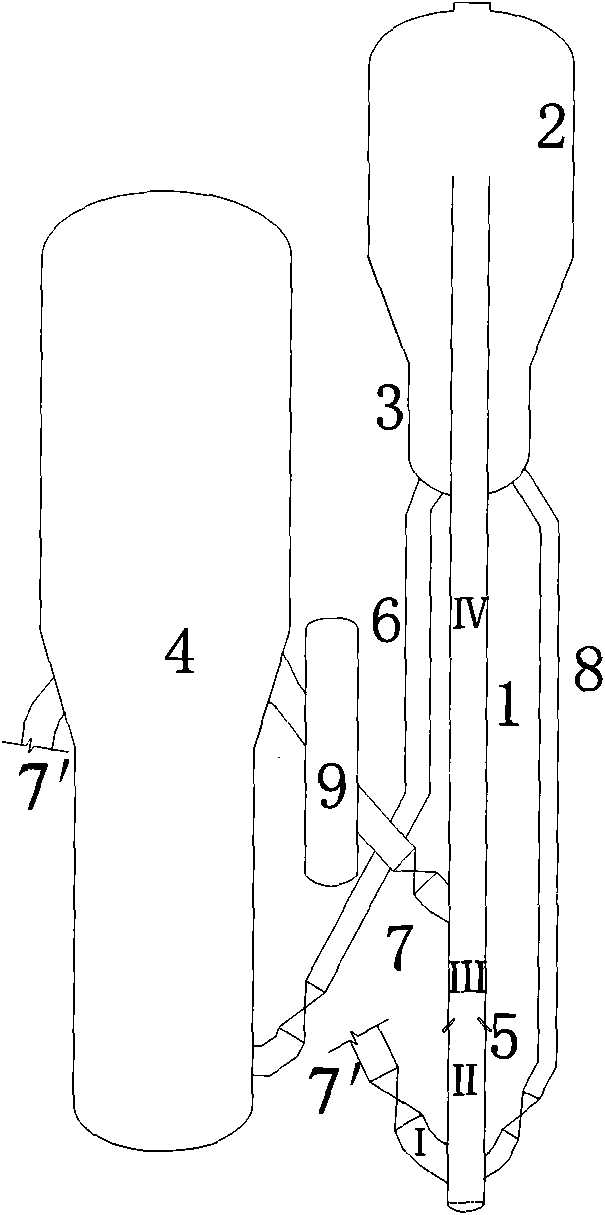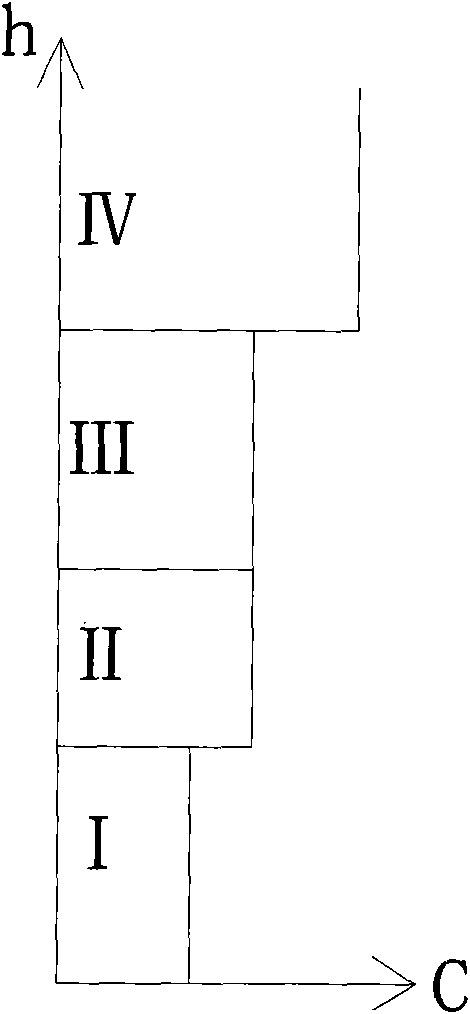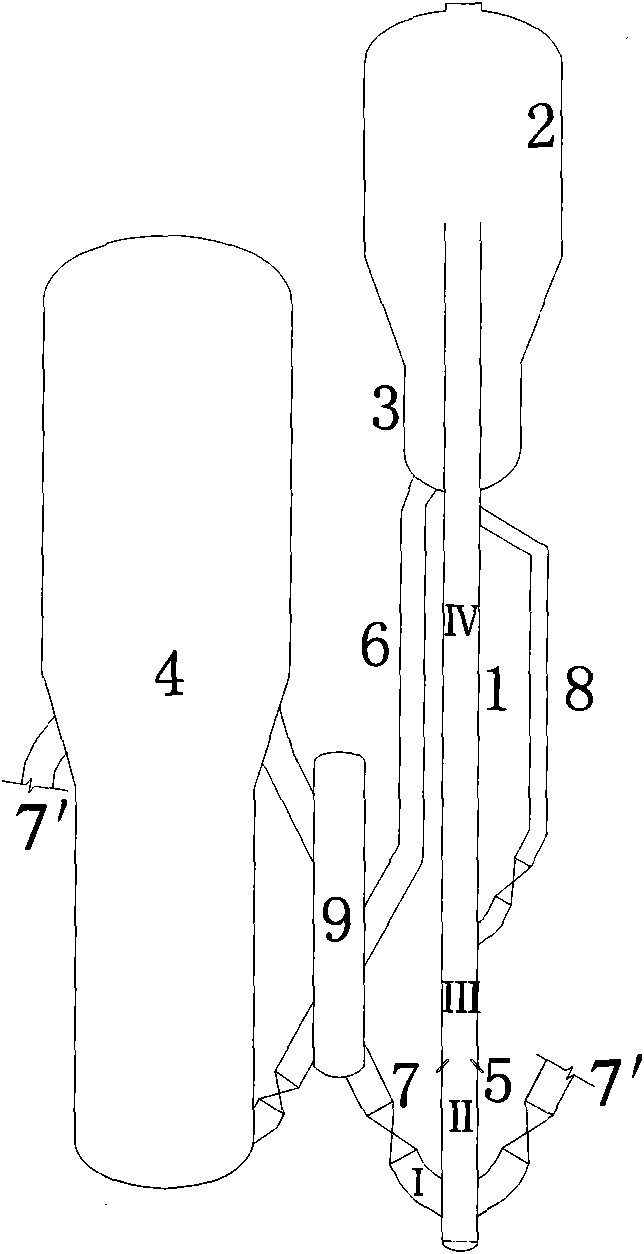Catalytic conversion method and device for single-riser petroleum hydrocarbon type raw material
A catalytic conversion method and riser technology, applied in the field of single riser petroleum hydrocarbon feedstock catalytic conversion method and device, can solve the problems of inability to adjust the ratio of catalyst to oil, less catalyst storage, and inability to adjust and change, so as to reduce dry gas Yield, improvement of catalytic conversion reaction, effect of control
- Summary
- Abstract
- Description
- Claims
- Application Information
AI Technical Summary
Problems solved by technology
Method used
Image
Examples
Embodiment 1
[0029] Example 1: see figure 1 . The ungenerated catalyst from the stripping section 3 returned through the catalyst return pipe 8 is mixed with a part of the hot regenerated catalyst entering from the regeneration standpipe 7' in the pre-lift section II at the bottom of the riser reactor 1, and then upwardly passes through the feed nozzle 5 The incoming atomized feedstock oil is contacted to participate in the catalytic reaction; the reaction mixture is upwardly contacted with the temperature-reduced regenerated catalyst formed by the regeneration standpipe 7 through the catalyst cooling device 9 and continues to react; the reactant flow is separated in the settler 2, and the The raw catalyst is stripped in the stripping section 3, part of it enters the pre-lift section II at the bottom of the reactor 1 through the return pipe 8, and the other part enters the regenerator 4 through the standpipe 6 for regeneration.
[0030] In this embodiment, the distribution of catalyst cir...
Embodiment 2
[0031] Example 2: see image 3. A part of the hot regenerated catalyst entering from the regeneration standpipe 7 passes through the catalyst cooler 9 to form a cooling regenerated catalyst, and after being mixed with another part of the hot regenerated catalyst entering from the regeneration standpipe 7′ in the pre-lift section II at the bottom of the riser reactor 1, Contact upward with the atomized raw material oil that enters through the feed nozzle 5 to participate in the catalytic reaction; the reaction mixture is upwardly contacted with the spent catalyst from the post-reaction section III that flows back through the catalyst return pipe 8 to continue the reaction; the reactant flows along the post-reaction section III Upward, a part of the catalyst to be produced is refluxed into the rear reaction section through the return pipe 8 to participate in the reaction, and the rest of the reaction mixture enters the settler 2 and the stripping section 3 upwards and is separat...
Embodiment 3
[0032] Embodiment 3: see Figure 4 . The cooled regenerated catalyst that enters from the regeneration riser 7 and is cooled by the catalyst cooler 9 enters the bottom of the riser reactor 1, and contacts upwardly with the atomized raw material oil that enters through the feed nozzle 5 to participate in the catalytic reaction; The raw catalyst from the stripping section 3 returned by the reflux pipe 8 contacts and continues to react; the reactant flow is separated in the settler 2, and the raw catalyst is stripped in the stripping section 3, and a part enters the riser reactor 1 through the reflux pipe 8 In the post-reaction section, the other part enters the regenerator 4 for regeneration through the standby riser 6.
[0033] In this embodiment, the distribution of catalyst circulation from bottom to top along the riser reactor is as follows Figure 5 As shown, the cooling regenerated catalyst in the pre-lifting section II enters the oil agent contact section III upwards, a...
PUM
 Login to View More
Login to View More Abstract
Description
Claims
Application Information
 Login to View More
Login to View More - R&D
- Intellectual Property
- Life Sciences
- Materials
- Tech Scout
- Unparalleled Data Quality
- Higher Quality Content
- 60% Fewer Hallucinations
Browse by: Latest US Patents, China's latest patents, Technical Efficacy Thesaurus, Application Domain, Technology Topic, Popular Technical Reports.
© 2025 PatSnap. All rights reserved.Legal|Privacy policy|Modern Slavery Act Transparency Statement|Sitemap|About US| Contact US: help@patsnap.com



